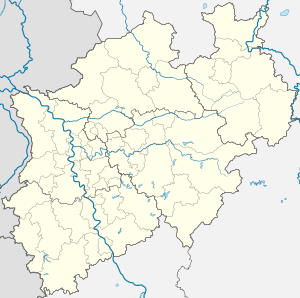Erkrath station
Erkrath station is a through station in the town of Erkrath in the German state of North Rhine-Westphalia. It has two platform tracks and it is classified by Deutsche Bahn as a category 5 station.[1]
| Through station | ||||||||||||||||
Beginning of the climb to Hochdahl | ||||||||||||||||
| Location | Morper Allee 1, Erkrath, North Rhine-Westphalia Germany | |||||||||||||||
| Coordinates | 51°13′13″N 6°54′11″E | |||||||||||||||
| Line(s) | Düsseldorf–Elberfeld (KBS 450.8) | |||||||||||||||
| Platforms | 2 | |||||||||||||||
| Other information | ||||||||||||||||
| Station code | 1646[1] | |||||||||||||||
| DS100 code | KER[2] | |||||||||||||||
| IBNR | 8001841 | |||||||||||||||
| Category | 5[1] | |||||||||||||||
| Fare zone | ||||||||||||||||
| Website | www.bahnhof.de | |||||||||||||||
| History | ||||||||||||||||
| Opened | 20 December 1838 [5] | |||||||||||||||
| Services | ||||||||||||||||
| ||||||||||||||||
| Location | ||||||||||||||||
 Erkrath station Location within North Rhine-Westphalia | ||||||||||||||||
History
The station was opened along with the Düsseldorf–Elberfeld railway from Düsseldorf to Erkrath by the Düsseldorf-Elberfeld Railway Company on 20 December 1838.[6] The line between Erkrath and Hochdahl has a gradient of 3.33% and rises 82 m in about 2.5 km. For more than one hundred years, this was the steepest main line in Europe. For many years trains had to be hauled by cable, originally driven by a stationary steam engine. A few months later haulage by cable attached to a stationary steam engine was changed to haulage by cable attached via pulleys to a locomotive running downhill on an additional track. With the duplication of the remainder of the line in 1865, the steep section of line became three-track, until the electrification of the line in 1963. The third track was rebuilt in 1985, as part of the additional third track built for the planned S-Bahn line. In 1926, cable haulage on the incline was replaced by bank engines.
Services
The station is served by the Rhine-Ruhr S-Bahn lines S 8 between Mönchengladbach and Wuppertal-Oberbarmen or Hagen every 20 minutes and several S 68 services between Wuppertal-Vohwinkel and Langenfeld in the peak hour.[7]
It is also served by four bus routes operated by Rheinbahn: O5 (every 20–60 minutes), O6 (20), 734 (60) and 743 (60).
References
- "Stationspreisliste 2020" [Station price list 2020] (PDF) (in German). DB Station&Service. 4 November 2019. Retrieved 15 November 2019.
- Eisenbahnatlas Deutschland (German railway atlas) (10 ed.). Schweers + Wall. 2017. ISBN 978-3-89494-146-8.
- "Wabenplan für das Rheinbahn-Bedienungsgebiet" (PDF). Rheinbahn. 1 August 2008. Retrieved 31 October 2019.
- "Ticketberater". Verkehrsverbund Rhein-Sieg. Retrieved 12 June 2020.
- "Erkrath station operations". NRW Rail Archive (in German). André Joost. Retrieved 30 October 2011.
- "Line 2550: Aachen - Kassel". NRW Rail Archive (in German). André Joost. Retrieved 3 March 2018.
- "Erkrath station". NRW Rail Archive (in German). André Joost. Retrieved 30 October 2011.